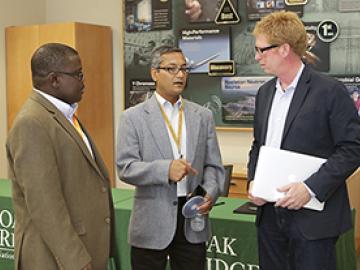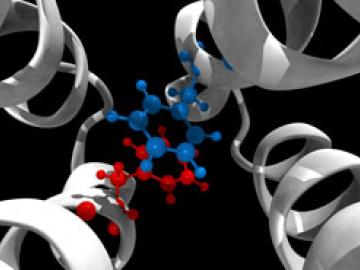
Filter News
Area of Research
- (-) Chemistry and Physics at Interfaces (4)
- (-) Supercomputing (115)
- Advanced Manufacturing (14)
- Biological Systems (15)
- Biology and Environment (42)
- Biology and Soft Matter (1)
- Building Technologies (3)
- Clean Energy (187)
- Climate and Environmental Systems (2)
- Computational Biology (4)
- Computational Engineering (2)
- Computer Science (6)
- Electricity and Smart Grid (1)
- Energy Frontier Research Centers (7)
- Energy Sciences (3)
- Fossil Energy (2)
- Fuel Cycle Science and Technology (1)
- Functional Materials for Energy (8)
- Fusion and Fission (19)
- Fusion Energy (2)
- Geographic Information Science and Technology (2)
- Isotope Development and Production (1)
- Isotopes (10)
- Materials (226)
- Materials Characterization (2)
- Materials for Computing (13)
- Materials Synthesis from Atoms to Systems (5)
- Materials Under Extremes (5)
- National Security (25)
- Neutron Science (80)
- Nuclear Science and Technology (27)
- Nuclear Systems Modeling, Simulation and Validation (1)
- Nuclear Systems Technology (1)
- Quantum Condensed Matter (1)
- Quantum information Science (2)
- Reactor Technology (1)
- Sensors and Controls (1)
- Transportation Systems (5)
News Type
News Topics
- 3-D Printing/Advanced Manufacturing (3)
- Artificial Intelligence (14)
- Big Data (2)
- Bioenergy (6)
- Biology (4)
- Biomedical (6)
- Biotechnology (1)
- Buildings (2)
- Chemical Sciences (3)
- Climate Change (3)
- Computer Science (33)
- Coronavirus (5)
- Cybersecurity (6)
- Decarbonization (2)
- Energy Storage (6)
- Environment (4)
- Exascale Computing (10)
- Frontier (14)
- Grid (4)
- High-Performance Computing (16)
- Isotopes (1)
- Machine Learning (6)
- Materials (10)
- Materials Science (7)
- Microscopy (5)
- Molten Salt (1)
- Nanotechnology (5)
- National Security (5)
- Neutron Science (7)
- Nuclear Energy (2)
- Partnerships (1)
- Physics (4)
- Quantum Computing (5)
- Quantum Science (11)
- Security (4)
- Simulation (4)
- Software (1)
- Space Exploration (1)
- Summit (15)
- Sustainable Energy (6)
- Transportation (2)
Media Contacts

Less than 1 percent of Earth’s water is drinkable. Removing salt and other minerals from our biggest available source of water—seawater—may help satisfy a growing global population thirsty for fresh water for drinking, farming, transportation, heating, cooling and industry. But desalination is an energy-intensive process, which concerns those wanting to expand its application.

Graphene, a strong, lightweight carbon honeycombed structure that’s only one atom thick, holds great promise for energy research and development. Recently scientists with the Fluid Interface Reactions, Structures, and Transport (FIRST) Energy Frontier Research Center (EFRC), led by the US Department of Energy’s Oak Ridge National Laboratory, revealed graphene can serve as a proton-selective permeable membrane, providing a new basis for streamlined and more efficient energy technologies such as improved fuel cells.




Knoxville-based Fiveworx has licensed an Oak Ridge National Laboratory technology that will help consumers reduce their utility bills by analyzing their home energy usage.

Treating cadmium-telluride (CdTe) solar cell materials with cadmium-chloride improves their efficiency, but researchers have not fully understood why.

Researchers at the Department of Energy’s Oak Ridge National Laboratory and the University of Tennessee, Knoxville have pioneered a new technique for forming a two-dimensional, single-atom sheet of two different materials with a seamless boundary.




